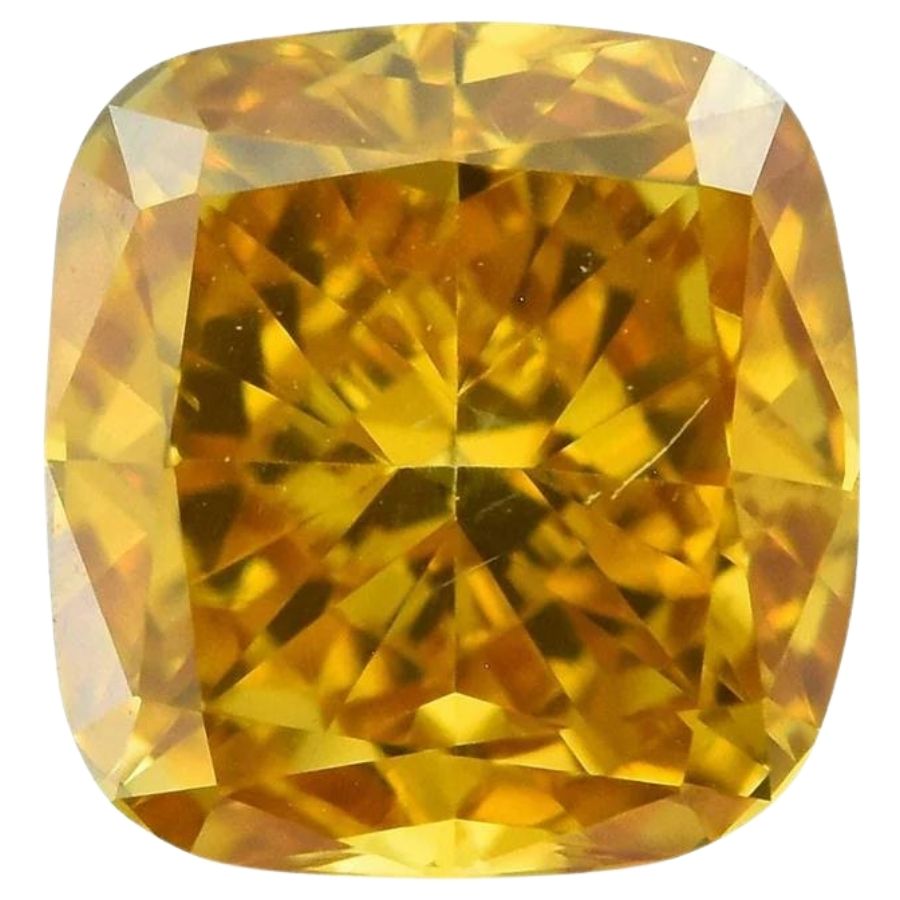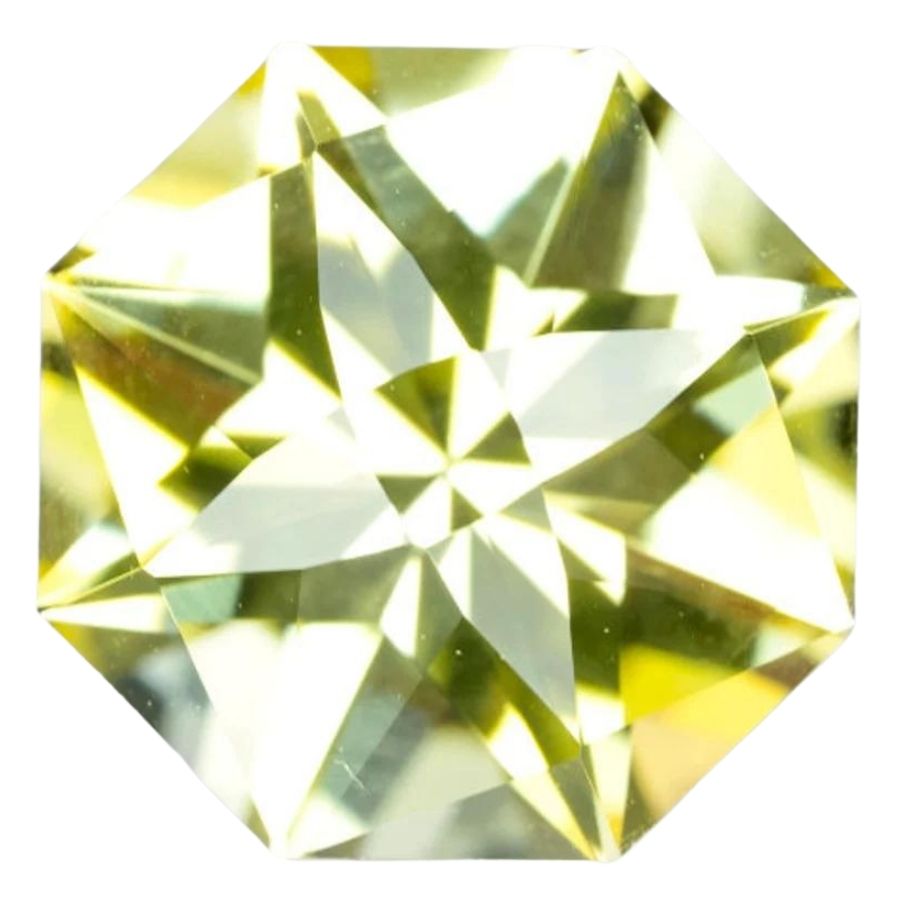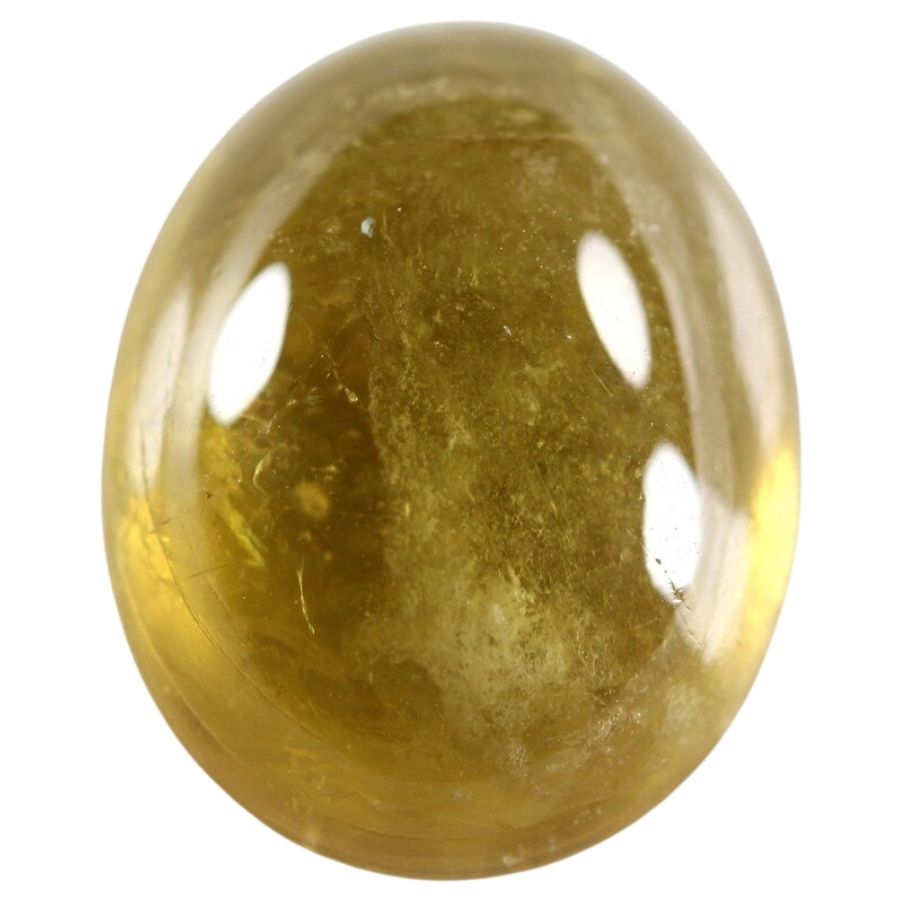Yellow diamonds, amber, and citrine are just a few examples of the amazing variety of yellow crystals out there. Each of these crystals has a unique story, shaped by the very fabric of the planet.
What makes these yellow gems, rocks, and minerals so captivating is their diverse properties and the roles they play. Some are valued for their stunning beauty and are often used in jewelry, while others have practical uses in industry.
These yellow gems are not just pretty to look at; they hold secrets of geological processes and Earth’s history. Every discovery of a yellow crystal or mineral is a reminder of the Earth’s dynamic processes.
Our Favorite Yellow Crystals
We find these yellow gems fascinating because of their sunny colors, the way they capture light, and many other factors. Each crystal also tells a unique story of Earth’s history.
Yellow Diamond

Yellow diamonds get their stunning color from tiny amounts of nitrogen trapped inside as they form deep in the Earth, under extreme heat and pressure.
These conditions are so intense that they change pure carbon into the crystal we know as diamond.
Also, yellow diamonds are rare and are found in only a few places worldwide, which makes them quite special.
What really sets yellow diamonds apart is their unique color. From light lemon hues to deep amber shades, each yellow diamond has its own personality. This color variation is a big part of what makes them valuable.
Another factor that adds to their worth is clarity, or how clear the diamond is. Rarely, we find a yellow diamond with very few internal marks, and these are especially prized. The way they’re cut and shaped also adds to their sparkle and value.
Yellow Sapphire

Yellow sapphire is part of the corundum family like blue sapphires and rubies. It forms deep within the Earth when aluminum oxide combines with trace amounts of iron, giving it a distinct yellow hue.
The color of yellow sapphire can range from pale lemon to rich golden, each shade offering its own unique beauty. These gems are often found in alluvial deposits, where they’ve been transported by natural processes.
People appreciate yellow sapphire for its bright color and remarkable hardness, making it suitable for everyday wear. The intensity and uniformity of its color play a significant role in its appeal; vivid and consistent hues are often more desirable.
The clarity of the stone is also important; stones with fewer internal marks are more sought after. The way yellow sapphire is cut can enhance its brilliance and color, making a well-cut stone more attractive for jewelry.
Citrine

Citrine, a member of the quartz family, stands out with its warm yellow to orange-brown hues. It forms when amethyst, another type of quartz, is heated naturally in the Earth. The heat then changes the amethyst’s color.
The color of citrine is a key feature; it ranges from a pale, lemony shade to a deep, earthy brown, making each piece unique.
A lot of citrine on the market isn’t natural; it’s made by heat-treating amethyst, another type of quartz. This process changes the color of amethyst to resemble citrine, but it’s not the real thing.
If a “citrine” has a bright orange color, then it’s likely not natural citrine. Matural and untreated citrine is quite rare, making it a special find for gem collectors.
This rarity adds to its value, as does its color and clarity. The more intense and clear the color, the more valuable the citrine is.
Yellow Topaz

Yellow topaz forms in various types of rocks where fluorine gases are present, often in areas with volcanic activity or in pegmatites, which are very coarse-grained rocks.
The unique environment where topaz forms allows it to develop large, well-shaped crystals.
The bright, sunny yellow color of yellow topaz can range from pale to a deep, golden hue. Sometimes, topaz can be treated to enhance this natural beauty.
Color intensity is a big factor in determining the value of yellow topaz. More vivid and pure yellow tones are usually more desirable. Clarity is crucial too; the clearer the stone, without internal marks or inclusions, the more valuable it is.
The way yellow topaz is cut also enhances its beauty and value, as a skilled cut can maximize the stone’s sparkle and show off its color best. Durability is another advantage of topaz, making it suitable for all kinds of jewelry.
Amber

Amber is fascinating because it’s not a typical mineral. Instead, it’s fossilized tree resin. It starts as sticky sap from ancient trees, often pine, that over millions of years, gets buried and hardens into what we call amber.
It’s not just a pretty gem; amber is like a time capsule, often trapping small insects or plant material from millions of years ago.
The color of amber ranges from a pale yellow to a rich, deep orange, each piece having its own character. The clarity and the presence of inclusions, like insects or plants, can make a piece of amber more interesting and sought after.
Larger pieces of amber are generally more valued, especially if they have rare or unique inclusions. People love amber for its warm colors and the fascinating stories it holds from millions of years ago.
Yellow Zircon

Yellow zircon is a dazzling gemstone, known for its bright and fiery color. It forms when zirconium silicate crystals grow in the Earth’s crust, a process that takes millions of years.
The presence of trace elements, often uranium and thorium, gives yellow zircon its distinctive color.
People are drawn to yellow zircon for several reasons. Its color intensity is a big attraction; more vivid yellows are often more sought after. The brilliance and sparkle of yellow zircon, due to its high refractive index, also add to its desirability.
The size and overall quality of the crystal are important too; larger, clearer stones are typically more valued. Yellow zircon is popular in jewelry for its resemblance to diamonds and its durability.
Dark Yellow Crystals
We’ve come across some dark yellow rocks and gems that stand out in a variety of ways. The deep, rich shades of yellow in these crystals are both beautiful and intriguing, but they also have characteristics that prove that they’re more than what meets the eye.
Yellow Tourmaline

Yellow tourmaline is part of the tourmaline family, known for its variety of shades. It forms in pegmatites, where minerals grow into large crystals, and gets its color from elements like manganese and iron.
The hues of yellow tourmaline can vary. You can get a pale lemon crystal or a rich, dark yellow crystal. However, brighter, more vivid yellows are usually more desirable. People also prefer clearer stones with fewer internal marks.
In addition, a good cut can maximize its brilliance and show off the color of yellow tournaline.
Heliodor

Heliodor is a striking gemstone, part of the beryl family, which includes emeralds and aquamarines. It’s known for its yellow hue.
This gem forms when beryllium, aluminum, silicon, and trace amounts of iron come together under the right conditions, giving it its sunny color. Heliodor is typically found in pegmatites, which are large crystal-filled rocks.
People are attracted to heliodor for several reasons. The intensity and purity of its yellow color play a significant role; brighter, more vivid yellows are often more sought after.
The clarity of heliodor also adds to its appeal; stones that are clear and free from internal marks are more prized. The way heliodor is cut can greatly enhance its beauty, making a well-cut stone more desirable for jewelry.
Yellow Opal

Yellow opal is a stunning gemstone, known for its radiant color that ranges from pale lemon to rich gold. It forms when silica from the ground mixes with water, creating a gel that hardens over time into opal.
This process happens in areas with a lot of silica-rich rocks. Some yellow opals show a play of color, sparkling with different hues, while others have a more consistent color.
These opals are popular in jewelry and loved for their warm, cheerful hues and unique appearance. They’re also sought after by collectors who appreciate their beauty.
The factors that contribute to their appeal include the intensity of the yellow color, with brighter shades often being more popular. The presence or absence of play of color also affects their desirability.
Yellow Aventurine

Yellow aventurine is a type of quartz that gets its yellow color from tiny inclusions of minerals, which give it a shimmering effect. This stone forms when silica-rich waters flow through rocks, picking up various minerals along the way.
Over time, these minerals become part of the quartz, creating the beautiful yellow aventurine.
This gemstone is not just pretty to look at; it’s also used in various ways. Yellow aventurine is popular in jewelry, like necklaces and bracelets, because of its attractive color and sparkle.
One of the big draws of yellow aventurine is its sunny, warm color, ranging from pale yellow to a deeper, mustard hue. The stone’s price is also affected by its color intensity and the uniformity of its inclusions.
Yellow Fluorite

Yellow fluorite is a striking mineral with a vibrant, sunny hue that really stands out. It forms from calcium fluoride, often found in areas with hydrothermal activity, where hot water and minerals mix underground.
This environment allows fluorite to crystallize into its unique colors, with yellow being one of its rarer shades. Its bright color can range from a soft, lemony yellow to a deep, golden amber, making each piece distinct.
Fluorite is also valued for its fluorescent properties and is used in some industrial processes. People also appreciate yellow fluorite for its decorative appeal; it’s often used in jewelry and as collectible specimens.
The factors contributing to the value of yellow fluorite include color intensity and the presence of unique features, like patterns or a strong fluorescence under ultraviolet light.
Barite

Barite is a fascinating mineral, known for its heavy weight and often striking crystal forms. It forms from the combination of barium, sulfur, and oxygen, often in areas with hydrothermal activity.
This process allows barite to develop into various shapes, including tabular crystals or more earthy, massive forms. Barite’s colors range from white and colorless to shades of yellow and other colors.
Barite’s crystal shape is one big draw; clear, well-formed crystals are highly appreciated by collectors. Its range of colors also adds to its appeal; though often colorless, when colored, it can be quite striking.
One of the most notable features of barite is its high specific gravity; it’s much heavier than it looks, surprising many people who handle it.
Barite also has practical uses in industries like oil drilling and manufacturing paint.
Pyrite

Pyrite, often called “fool’s gold,” is a shiny, metallic-looking mineral that’s famous for its gold-like appearance. The way pyrite reflects light and its brassy yellow color make it easy to spot and a favorite among rock collectors.
It forms when iron and sulfur combine under certain conditions, often in sedimentary rocks like shale or in coal beds. Pyrite can also form in igneous rocks and sometimes appears in beautiful, well-formed cubic crystals.
Its crystal shape is a big attraction; well-formed crystals are really popular. The luster and color of pyrite also add to its appeal; that gold-like shine makes it stand out.
Pyrite is not just pretty to look at; it was also used in making sulfuric acid and as a source of sulfur. People are drawn to pyrite for its striking looks and its interesting role in both history and industry, making it a significant and fascinating mineral.
Light Yellow Crystals
We’ve discovered some amazing light yellow gems and minerals that aren’t just interesting, but some are also quite versatile. Their versatility makes them perfect for various uses, including stunning jewelry that showcases their unique beauty.
Yellow Calcite

Yellow calcite forms when calcium carbonate crystallizes, often in sedimentary environments like limestone or marble. This process can happen in various conditions, leading to the formation of calcite in a range of sizes and shapes.
Yellow calcite gets its sunny color from traces of iron and other minerals, giving it a warm, golden hue.
Color plays a big role when it comes to figuring out what . Its color is a big one; the brighter and more vivid the yellow, the more attractive it is to collectors and enthusiasts.
The clarity and size of the calcite crystals also play a role in their value; larger, clearer pieces are often more sought after.
Yellow calcite is also valued for its decorative appeal; its ability to be carved and polished makes it popular for ornaments and jewelry. People are drawn to yellow calcite for its uplifting color and the way it adds a sunny touch to their collections and creations.
Yellow Apatite

Yellow apatite is a striking gemstone, part of the apatite family of minerals. It forms from calcium phosphate combined with trace elements, often in areas where rocks are exposed to high temperatures.
This process gives this light yellow crystal its distinctive color and form. It’s typically found in pegmatite rocks and sometimes in sedimentary deposits.
The brightness of yellow apatite is a big attraction; a well-saturated yellow is particularly appealing. Its clarity also adds to its allure; stones that are clear and free from inclusions are more prized.
Yellow Garnet

Yellow garnet is a striking and diverse gemstone in the large garnet family, which includes many different types. Hessonite and andradite topazolite are the varieties of garnet that often come in yellow.
These types of garnet form under various conditions where elements like calcium, aluminum, and silicon combine in the Earth. The specific composition and conditions give yellow garnet its yellow hues.
People are drawn to yellow garnet for its bright color and remarkable hardness, making it suitable for everyday wear.
The intensity and uniformity of its color play a significant role in its appeal; more vivid and consistent hues are often more desirable.
Yellow garnet is treasured for its blend of durability, beauty, and the unique conditions under which it forms, making it a prized gemstone in the world of geology.
Sulfur

Sulfur is a bright yellow, non-metallic element that’s both beautiful and essential in many ways. It often forms near volcanic areas or hot springs, where it crystallizes from gases coming out of the Earth.
Sulfur can also be found in sedimentary environments, originating from the breakdown of organic materials. Its distinct yellow color and powdery texture make sulfur easy to identify.
Its color and crystal form are especially appealing to mineral collectors. The purity of sulfur is important, too; the more pure it is, the more useful it is in various industrial processes.
Sulfur has a wide range of uses, from making fertilizers and chemicals to its role in some medicines. People also value sulfur for its historical importance; it has been used since ancient times for various purposes.
Yellow Orthoclase

Yellow orthoclase is a captivating mineral, part of the feldspar family, and it’s known for its warm, yellow hues. It forms from a mix of potassium, aluminum, and silica under conditions often found in the Earth’s crust.
These elements come together in just the right way to create orthoclase’s unique color. The presence of trace elements, like iron, can influence the intensity of its yellow shade.
The color of the stone is a major draw; the more vibrant and consistent the yellow, the more appealing it is. The crystal size and quality are also important; larger, well-formed crystals are particularly valued.
Yellow orthoclase is often used in jewelry and as decorative pieces, where its color and luster can be showcased. Its durability makes it suitable for various uses, adding practical value.
Yellow Chrysoberyl

Yellow chrysoberyl is a remarkable gemstone, known for its durability and striking color. It forms when beryllium, aluminum, and oxygen combine under high temperature and pressure, typically in pegmatite rocks.
The presence of iron gives chrysoberyl a sunny hue, ranging from pale lemon to a deep golden color. Its hardness makes it resistant to scratches, ideal for everyday jewelry.
The intensity of its color is a big attraction; brighter and more vivid shades are usually more sought after. The clarity of the gemstone also plays a role; clear, flaw-free stones are highly valued.


